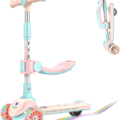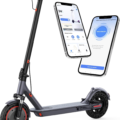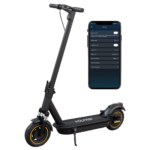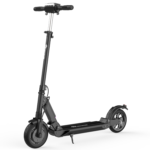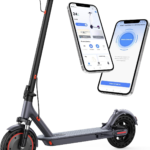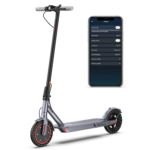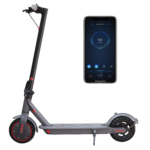- Home
- Scooters
- Electric Scooters
- VOLPAM SPT7
VOLPAM SPT7
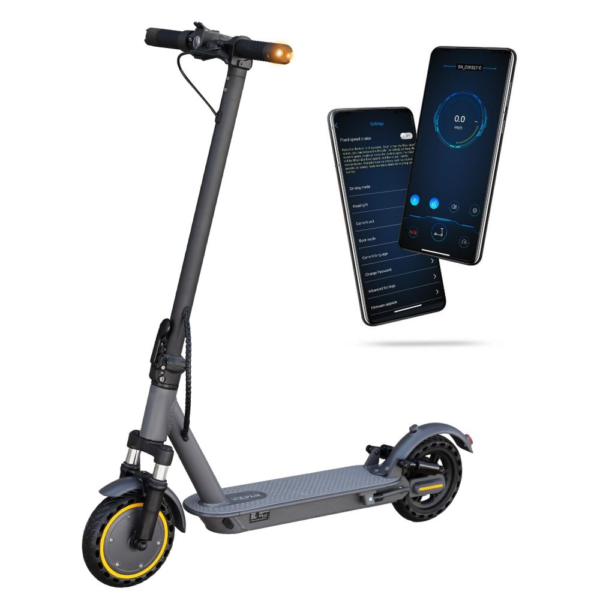

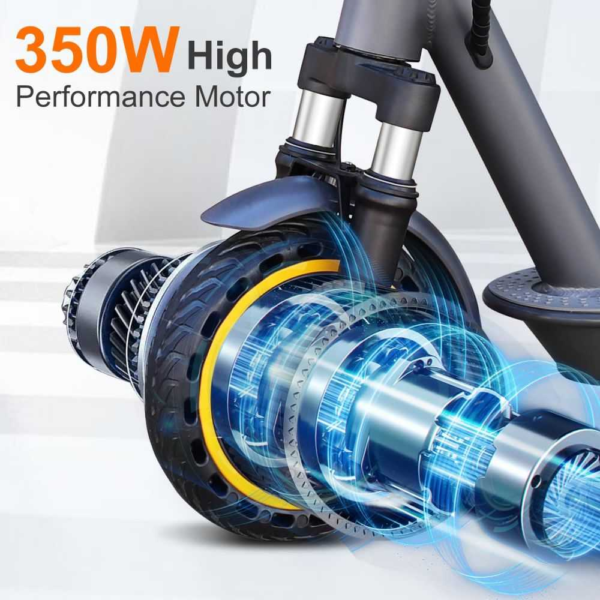
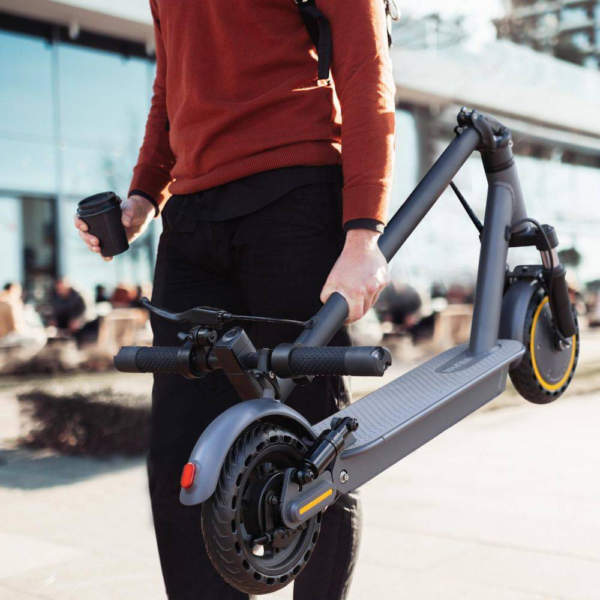
- Battery Range: 20 miles (32 km)
- Top Speed: 19 mph (31 km/h)
- Motor Power: 350 W
- Weight Capacity: 264 lb (120 kg)
- Charging Time: Approx. 4–5 hours
- Scooter Weight: 26.5 lb (12.0 kg)
PROS
- Dual suspension for smoother rides
- Turn signals plus full lighting
- Dual braking: electronic + rear drum
- 8.5″ honeycomb solid tires
- Cruise control and riding modes
CONS
- Solid tires transmit road buzz
- IP rating not published
- Dimensions not specified
- Modest hill climbing
Key Takeaways
- The VOLPAM SPT7 is a compact, foldable scooter with a 350W motor and a range of 17-20 miles, ideal for city commuting.
- It features solid honeycomb tires, dual suspension, and three ride modes for various riding conditions.
- The scooter includes essential safety features like lights and brake signals, enhancing visibility while riding.
- Weighing about 26.5 lb, it is portable, making it easy to fold and transport in vehicles or public transport.
- Regular maintenance ensures the VOLPAM SPT7 remains reliable and performs efficiently over time.
Table of contents
- What Is the VOLPAM SPT7?
- How the VOLPAM SPT7 Works
- Key Specifications
- Design & Build Quality
- Performance Fundamentals
- Battery, Range & Efficiency
- Ride Quality & Comfort
- Braking & Safety Features
- Portability & Daily Usability
- Maintenance & Care
- Weather & Seasonal Considerations
- VOLPAM SPT7 vs Alternatives
- Who the VOLPAM SPT7 Is (and Isn’t) For
- FAQs
- Glossary
- Final Notes on Fit and Use
The VOLPAM SPT7 is a compact city scooter with a 350W hub motor, dual suspension, and 8.5-inch solid tires. It suits riders who want easy care, clear controls, and steady pace on flat streets. It trades air-tire plushness for zero flats, and it leans toward range and simplicity over raw speed. So if you want a grab-and-go commuter for short to mid trips, this fits.
What Is the VOLPAM SPT7?
The VOLPAM SPT7 is a foldable commuter in the entry-to-mid class. It runs a 350W rear hub on a 36V system with a deck-mounted battery built for daily city use. Top speed reaches up to 19 mph (30 km/h) in the fastest mode. Range lands around 17–20 miles (27–32 km) with light loads and a calm pace. And since the frame carries dual spring suspension, the deck stays calmer over brick, patched asphalt, and small speed humps. The honeycomb solid tires skip tubes and flats. Braking pairs a rear drum with front electronic regen, so stops feel smooth and low-care.
You get a bright LED display, three ride modes, cruise control, and built-in lights with a headlight, a tail light, and bar-end turn signals. The stem folds for trains, rideshares, or office storage. And at about 26.5 lb (12 kg), most people can carry it up a flight of stairs without much effort.
How the VOLPAM SPT7 Works
Motor and controller. A brushless 350W rear hub pulls you off the line with a gentle surge. The controller meters current, so launches feel calm, not jumpy. On flat ground, the motor holds speed without twitchy throttle changes. And on short hills, it slows a bit, then finds a steady pace.
Battery and power flow. A 36V pack feeds the controller. Voltage stays fairly stable through most of the charge, so speed feels consistent until the last bars. Rider weight, route, wind, and temperature shift draw. So expect faster drain on cold, hilly days.
Throttle and modes. A thumb throttle controls output. Three modes cap speed and power. Use Eco for crowded streets, Standard for daily bike lanes, and Sport for open paths. Cruise control kicks in after a steady hold, and your wrist gets a break on longer straight runs.
Brakes and regen. The rear drum does most of the work. The front electronic brake adds motor drag, so the last bit of speed comes off cleanly without pad wear. Squeeze the lever and ease the throttle, and the scooter settles into a firm, predictable stop.
Lighting and signals. The headlight and tail light help you stay seen at dusk. Bar-end turn signals give a clear cue for lane changes. And the display shows speed, mode, and battery bars at a glance.
Key Specifications
Official items come first here. If the brand does not publish a detail, the table says so. Some regions ship with lower speed caps for rules, so top speed can vary by market.
| Block | Details |
|---|---|
| General | Type: Foldable commuter e-scooter. Frame: alloy stem and deck. Tires: 8.5 in (216 mm) honeycomb solid. Display: large LED. Turn signals: left and right, handlebar mounted. |
| Performance & Power | Motor: 350W brushless rear hub. Top speed: up to 19 mph (30 km/h). Regional limit: some listings cap at 15.5 mph (25 km/h). Hill use: best on mild grades; speed drops on longer climbs. |
| Battery, Charging & Electrical | System voltage: 36V. Capacity: not published by the brand. Claimed range: 17–20 miles (27–32 km) per charge with lighter loads and steady pace. Charge time: about 4–5 hours. Charger: included. Cruise control: steady-throttle activation. |
| Build & Dimensions | Weight: 26.5 lb (12 kg). Max rider load: 264 lb (120 kg). Unfolded size: 42.1 × 16.9 × 43.3 in (1070 × 430 × 1100 mm). Folded size: 42.1 × 16.9 × 20.9 in (1070 × 430 × 530 mm). |
| Safety & Control | Brakes: rear drum + front electronic braking (regen). Suspension: dual spring, front and rear. Lighting: headlight, tail light, turn signals. Reflectors: fitted. Water resistance: no formal IP rating listed on the product page. |
| Features & Extras | Three ride modes. Cruise control. Kickstand. Stem fold latch. Basic tool kit in box. |
| Warranty & Compliance | Warranty: provided by seller or brand support; terms vary by region. Compliance: local speed rules may apply; check before riding. |
These specifications sketch a light, simple city scooter with a flat-route focus. They favor quick folds, short charge stops, and low-stress upkeep. So if you want more peak power or longer suspension travel, you step up into heavier classes.
Design & Build Quality
The SPT7 keeps things tidy. The stem locks with a simple latch, so fold-and-lift takes seconds. The deck gives enough room for a relaxed staggered stance. The honeycomb tires fill the wells and hold their shape in heat or cold, so the scooter looks clean and stays ready after long rests. The cockpit is familiar: thumb throttle on the right, brake lever on the left, a centered display, and simple buttons for power and lights. And those bar-end indicators help drivers read your intent in traffic.
Fit and finish land where a commuter should. Plastics sit tight around the display and cable runs, and wiring stays tucked near the stem. The deck rubber grips well in rain or dust. The rear fender sits close without rubbing when aligned. The folding joint is the main moving part, so give it a quick check each week. Tighten play early, and you avoid stem wobble at speed. You get a small tool kit in the box, and routine bolts are easy to reach.
Performance Fundamentals
Starts and pace. From a push start, the 350W motor comes on smoothly. In Sport, it climbs to the mid-teens fast, then eases toward top speed. At 19 mph (30 km/h), the chassis feels steady on clean paths. On rougher asphalt, the springs shave off small hits while the solid tires keep a firm line.
Cruising stability. A longish stem and low deck help it track straight. Keep both hands planted, and it holds a line across cracks and paint. The honeycomb tires ignore pinch, so flat risk stays low. They do not soften like air tires, but the springs take the edge off at a sane pace.
Hill behavior. On short 7–10% grades, speed dips yet the scooter keeps moving in Sport. Lighter riders hold more pace. Heavier riders see more drop. So shift a bit forward for grip, keep the throttle steady, and let the motor work. Long hills drain bars faster, so plan routes that zig around the steepest blocks when you can.
Battery, Range & Efficiency
Rated vs real-world. The claim of 17–20 miles (27–32 km) fits light riders, mild temps, and a relaxed cruise. City stop-and-go, hills, cold, and headwinds trim that. So a 180 lb (82 kg) rider on mixed streets often sees range in the mid-teens in miles. A 130 lb (59 kg) rider on flat lanes can land near the high end.
What shifts range. Three things matter most: speed, weight, and temperature. Speed stacks energy use fast, so cruising near 13–15 mph (21–24 km/h) stretches the pack. Extra cargo and heavy backpacks add draw. Cold knocks capacity down. Warm the scooter indoors before charging, and you claw some range back.
Charging habits. Use the stock charger on a dry, open surface. Let the pack rest 20–30 minutes after a ride, then plug in. For storage longer than a week, leave it around 50–70%. Try not to run it to empty. Top up after rides instead. These small habits keep the pack happier.
Efficiency tips. Pick the mode that fits the street. Eco helps in dense traffic. Standard suits steady bike lanes. Sport is there for quick passes and short hills. Keep the deck rubber clean for better grip at the same power.
Ride Quality & Comfort
Tires. Honeycomb solids remove flats from your life. They last a long time, they never need air, and they keep shape in heat or cold. The trade is feel. They send more buzz into the deck on cracked pavement. So the SPT7’s dual springs take the edge off that buzz, and hands and knees stay fresh on five-to-eight mile trips.
Suspension. The springs do best with small, repeated hits: joints, pavers, driveway lips. They are not long-travel units for trail riding. So keep speed sensible on broken streets, and you stay in control. The chassis does not pogo if you avoid sharp throttle chops over bumps.
Ergonomics. The thumb throttle sits at a friendly angle. The brake lever wakes up with a half pull and stays consistent through the day. The deck length leaves room for a staggered stance. And the bar height fits most riders between about 5’4″ and 6’1″ (163–185 cm).
Braking & Safety Features
Drum plus electronic. The rear drum is steady and low-care. It works much the same in dry or light wet, and grit stays away from the shoes. The front electronic brake adds a gentle motor drag, so the last part of a stop feels smooth. Use both together, and you get short, controlled stops.
Lights and signals. The headlight marks your space on the road. Aim it a bit down so you do not glare others. The tail light brightens under braking. And the bar-end turn signals sit near driver eye level, which helps in city traffic. Tap early and hold your line so people can react.
Water use. The product page does not list a formal IP rating. So treat rain as a “only if you must” case. Slow for paint and steel plates. Dry the scooter after the ride. Keep water away from the charge port and display buttons.
Portability & Daily Usability
Weight and carry. At roughly 26.5 lb (12 kg), the SPT7 is easy to lift into a trunk or up one set of stairs. Hold the stem near the hinge and rest the deck against your leg. The folded size—42.1 × 16.9 × 20.9 in (1070 × 430 × 530 mm)—fits small car trunks and tight office corners.
Fold steps. Power off. Drop the stem latch. Hook the bars to the deck. Then lift from the stem. Reverse the steps to ride. Latches wear in over time, so check fit each week and snug bolts if you feel play.
Storage and security. Keep it indoors when you can. Heat and sun age grips and plastics. Use a stout U-lock or thick folding lock through a solid frame point when you leave it outside. Snap a few photos and record the serial number. Good habits shrink risk.
Maintenance & Care
Keep a simple rhythm, and the scooter stays quiet and tight.
- Every ride: Quick visual scan. Look at tires, latches, and lights. Ring the bell. Squeeze the brake and feel for firm bite.
- Weekly: Check the fold joint for play. Tighten bar clamp bolts. Wipe the deck and frame. Confirm headlight, tail light, and signals.
- Monthly: Inspect the brake cable for fray. Listen for rub at the rear drum. Check tire tread and sidewalls. Look for loose screws at fenders and kickstand.
- Quarterly: Clean and re-grease the fold latch pivot if it creaks. Inspect the charge port cover. Check front wheel alignment to the stem.
Brake tuning. If lever travel feels long, turn the barrel adjuster a half turn. Spin the wheel to confirm no rub. Squeeze again, then repeat in small steps.
Battery care. Charge at room temp. Give the pack a cool-down before charging after hard rides. Unplug once full. For long breaks, park it around half charge and top up every few weeks.
Weather & Seasonal Considerations
Rain. Grip drops fast on paint, metal, and leaves. So slow down and make smooth inputs. Skip deep puddles, since there is no stated IP rating. Dry the deck and charge port afterward.
Heat. Hot days stress batteries. Park in shade. Let the pack cool before charging. Warm rubber grips better, so road feel can improve a touch.
Cold. Range shrinks in the cold. Bring the scooter inside to warm up before charging. Ride a bit slower, and keep your knees soft over rough patches.
Wind. Headwinds raise draw. Tuck elbows and hold a steady line. Use Standard in gusts for a gentler throttle ramp, then switch back to Sport when the path opens.
VOLPAM SPT7 vs Alternatives
Against lighter commuters. The SPT7 adds suspension, a drum brake, and turn signals where some ultra-light models skip them. Weight climbs a little, yet ride calm goes up on rough blocks. So if comfort and low care matter more than shaving ounces, this wins that swap. And if you need a safe starter for younger riders, take a look at the VOLPAM Kids e-scooter.
Against mid-power street scooters. Bigger scooters blast up hills and carry more speed in open space. They weigh more, cost more, and take more room at home. So if your rides are short and you favor easy upkeep, the SPT7 makes better sense. And if you want a simpler, lighter adult ride for short hops, the VOLPAM Q1 is an easy pick.
Against off-road or dual-motor builds. Those chase power and travel. They do not fit tight city life. And since the SPT7 aims at daily riders who need a low-stress tool, it lands as the better match for urban routes.
Where the SPT7 excels. Flat to rolling terrain. Short to mid city routes. Riders who want signals, cruise, and no-flat tires in one neat package.
Where it falls short. Long, steep hills. Rough trail use. Very tall riders who want wider bars or a taller stem.
Who the VOLPAM SPT7 Is (and Isn’t) For
Great for:
- City commuters with 3–8 mile one-way trips.
- Students who mix rides with buses or metros.
- New riders who want calm throttle ramps and predictable brakes.
- Multi-modal travelers who fold, lift, and stash often.
- Owners who like solid tires and fewer shop visits.
Not ideal for:
- Routes with long, steep climbs.
- Heavy riders who want fast hill pace.
- Riders who want the plush feel of air tires.
- Users who need 25+ miles per charge without a mid-day top-up.
FAQs
1) Is the VOLPAM SPT7 good for daily commuting?
Yes. It starts smoothly, holds mid-teens speed, and folds fast. Dual suspension calms rough blocks, and the weight is easy to manage.
2) What is the real-world range?
Plan for mid-teens in miles on mixed streets. Light riders on flat lanes can land near the upper claim. Cold and hills cut range, so leave a buffer.
3) How fast does it go?
Up to 19 mph (30 km/h) in the fastest mode. Some regions cap at 15.5 mph (25 km/h), so check your setting.
4) Does it have cruise control?
Yes. Hold steady throttle for a few seconds. You will see or hear a cue. Tap the brake or nudge the throttle to cancel.
5) What maintenance does it need?
Check the fold latch and brake cable weekly. Wipe the deck. Inspect lights. Tighten loose bolts. Solid tires keep flats off the list.
6) Can I ride in rain?
Light showers at low speeds are possible, yet there is no formal IP rating listed. So slow down, skip puddles, and dry it afterward.
7) Where can I find a VOLPAM SPT7 overview?
You are reading it now. It covers layout, ride, range, care, and specifications so you can decide if it fits your routes.
Glossary
- Ah (amp-hours): Battery capacity. More Ah means more stored charge.
- Wh (watt-hours): Voltage times capacity. A simple way to see total energy.
- Controller: The circuit that meters battery power to the motor.
- Regen (regenerative braking): The motor slows the wheel and feeds a bit of energy back.
- Stem flex: Small bend you feel in the steering tube at speed or over bumps.
- IP rating: Code for dust and water resistance levels.
- Honeycomb tire: A solid tire with voids that add some give and save weight.
- Drum brake: Shoes press inside a round drum for sealed, low-care stops.
- Hub motor: A motor built into the wheel hub.
- Cruise control: Holds speed after a steady throttle input.
- Ride mode: A preset for speed and power caps.
- Deck: The standing platform.
- Throttle ramp: How quickly power climbs after you push the throttle.
- Cutoff voltage: The point where the controller stops output to protect the pack.
- Nominal voltage: The rated system voltage for a battery, like 36V.
Final Notes on Fit and Use
This scooter shines when you want low stress and steady rides. Solid tires and a drum brake cut routine fixes. Dual springs take the sting out of rough patches. And the signals make your moves clearer in traffic. The trade is feel on sharp edges and slower hill pace. So keep that in mind, and the SPT7 will carry you through the week without fuss.
Last tip: keep a simple care routine. Check bolts, watch the fold joint, and treat the battery kindly. Small habits stack up over months. Then your scooter stays quiet, firm, and ready each morning.
Specifications
General
| Model The Model specifies the exact version or name of the scooter. It helps identify its unique design, features, and specifications within the manufacturer’s product line. Knowing the model makes it easier to compare options, find compatible accessories, or look up support information. | SPT7 |
| Brand The Brand identifies the manufacturer or company that designs and produces the scooter. A trusted brand is a sign of quality, reliability, and good customer support. Well-known brands often have higher standards for safety, performance, and after-sales service, giving you more confidence in your purchase. | VOLPAM |
| Release Date The Release Date indicates when the scooter model was officially launched on the market. This helps you know how current the design, technology, and features are. A newer release date often means updated components, improved performance, and the latest safety or smart features. | 18 November 2025 |
| Recommended Age Recommended Age indicates the minimum age range that the scooter is designed for, based on safety, size, and ease of use. Following the recommended age helps ensure that riders can handle the scooter’s speed, weight, and controls comfortably and safely. Always check local laws and use protective gear, especially for younger riders. | +16 |
Performance & Power
| Motor Power (Wattage) What it means: The motor power, measured in watts (W), shows how strong the scooter’s electric motor is. Why it matters: Higher wattage usually means better acceleration, more torque, and improved performance on hills or rough terrain. For example, a 250W motor is good for flat city roads and light riders, while a 500W or 1000W motor provides more power for faster speeds or climbing steep inclines. | 350 W brushless hub motor |
| Top Speed The Top Speed indicates the maximum speed that the scooter can reach under optimal conditions. It’s usually measured on level ground with a fully charged battery and an average rider weight. A higher top speed allows you to travel longer distances faster, but always ensure you ride within legal speed limits and your personal comfort zone for safety. | 19 mph (31 km/h) |
| Battery Capacity Battery Capacity refers to the total amount of energy the scooter’s battery can store, usually measured in ampere-hours (Ah) or watt-hours (Wh). A higher battery capacity means you can ride longer distances on a single charge, reducing the need for frequent recharging. Keep in mind that actual range can vary depending on rider weight, terrain, speed, and weather conditions. | 36 V (Ah/Wh Not specified) |
| Estimated Range per Charge The Estimated Range per Charge indicates the average distance the scooter can travel on a single full battery charge. This range is calculated under optimal conditions, such as flat terrain, moderate speed, and average rider weight. Real-world range may vary depending on riding style, terrain, weather, and load. A longer range means fewer recharges and greater freedom for longer trips. | 20 miles (32 km) |
| Hill Climb Ability Hill Climb Ability describes the maximum incline or slope that the scooter can handle while maintaining stable performance. It’s typically expressed as a percentage or in degrees. A higher hill climb rating means the scooter can tackle steeper hills without losing too much speed or power. Actual climbing performance may vary based on rider weight, battery charge, and terrain conditions. | Not specified |
| Drive System The Drive System refers to how power from the motor is delivered to the wheels. Electric scooters typically use either a hub motor (directly integrated into the wheel) or a chain/belt drive system. A high-quality drive system ensures smooth acceleration, efficient power transfer, and low maintenance. The choice of drive system affects performance, noise level, and overall ride experience. | Not specified |
Charging & Electrical
| Charging Time Charging Time indicates how long it takes to fully recharge the scooter’s battery from empty to 100% using the standard charger provided. Faster charging means less downtime and more time on the road. Actual charging time may vary slightly depending on battery capacity, charger output, and environmental conditions. | Approx. 4–5 hours |
| Battery Type Battery Type refers to the specific technology used in the scooter’s battery, which affects performance, lifespan, weight, and charging time. Most modern electric scooters use high-quality lithium-ion (Li-ion) batteries because they offer a good balance of energy density, durability, and low maintenance. A reliable battery type ensures consistent power delivery and longer riding ranges. | Lithium-ion |
| Removable Battery A Removable Battery means the battery pack can be easily detached from the scooter for convenient charging and replacement. This feature allows you to charge the battery separately, swap it with a spare for extended range, or securely store it indoors in extreme weather. Removable batteries add flexibility and make it easier to keep your scooter powered up wherever you are. | Non-removable internal battery |
| Regenerative Braking Regenerative Braking is an energy-saving feature that converts some of the energy normally lost during braking back into battery power. When you slow down or brake, the motor works in reverse to generate electricity, which helps extend the scooter’s range and improves overall efficiency. This system also reduces wear on traditional brake components, leading to lower maintenance over time. | Yes (electronic brake regen) |
| Lighting Lighting refers to the built-in front and rear lights that enhance visibility and safety when riding in low-light conditions or at night. Good lighting helps you see the road ahead and ensures that other road users can see you. Many scooters include LED headlights, taillights, and sometimes brake lights or side reflectors for added safety and compliance with local traffic regulations. | LED headlight + taillight + turn signals |
Build & Dimensions
| Scooter Weight Scooter Weight refers to the total weight of the scooter when fully assembled, including the battery. This affects how easy it is to carry, lift, and store the scooter when not in use. A lighter scooter is more portable and convenient for commuting, especially if you need to carry it upstairs or onto public transport. Keep in mind that a sturdy frame and quality components may add to the weight but also contribute to better durability and ride stability. | 26.5 lb (12.0 kg) |
| Maximum Rider Weight Maximum Rider Weight indicates the highest rider weight that the scooter is designed to safely support while maintaining optimal performance and stability. Staying within this limit helps ensure reliable acceleration, braking, and climbing ability, and it protects the frame, suspension, and motor from excessive strain. Exceeding the recommended limit may reduce performance and increase wear on components. | 264 lb (120 kg) |
| Deck Size Deck Size refers to the dimensions of the scooter’s standing platform. A wider and longer deck provides more foot space, allowing you to stand comfortably and adjust your stance while riding. A well-sized deck improves balance and stability, especially on longer rides or at higher speeds. Compact decks, on the other hand, help keep the scooter lightweight and portable. | Standard commuter geometry |
| Handlebar Height Handlebar Height refers to the distance from the deck to the handlebars, which affects your riding posture and comfort. An appropriate handlebar height helps you maintain good balance, reduces strain on your back and arms, and makes steering more comfortable. Some scooters have adjustable handlebars to fit riders of different heights, while others have a fixed height for a streamlined design. | Not specified |
| Folding Mechanism The Folding Mechanism describes how easily and securely the scooter can be folded for carrying and storage. A well-designed folding system lets you quickly collapse the scooter into a compact size, making it convenient to transport on public transit, store under a desk, or fit into a car trunk. Look for sturdy latches and safety locks to ensure the scooter stays firmly in place when folded or unfolded. | Quick-folding stem latch |
| Dimensions Folded Dimensions indicate the size of the scooter when it’s fully folded. This measurement shows how much space the scooter will take up when stored or carried, making it easier to check if it will fit in your car trunk, under a desk, or in a closet. Compact folded dimensions are ideal for commuters who need to bring their scooter on public transport or store it in tight spaces. | Not specified |
| Material Material refers to the primary construction materials used for the scooter’s frame and key components. High-quality materials like aircraft-grade aluminum, reinforced steel, or durable composites provide strength, stability, and a lighter overall weight. A sturdy material ensures the scooter can handle daily wear and tear while maintaining safety and performance. | Not specified |
Safety & Control
| Brake Type(s) Brake Type(s) describe the braking systems the scooter uses to help you slow down or stop safely. Common brake types include mechanical brakes (like drum or disc brakes), electronic brakes, and foot brakes. Many scooters combine multiple braking systems for added safety and shorter stopping distances. The type and quality of brakes affect your control, especially when riding at higher speeds or on slopes. | Front electronic + rear drum |
| Suspension Suspension refers to the system that absorbs shocks and vibrations while riding, providing a smoother and more comfortable ride over uneven or rough surfaces. Scooters may have front suspension, rear suspension, or dual suspension for better shock absorption and stability. Good suspension helps reduce rider fatigue and improves control, especially when riding on bumpy roads or off-road paths. | Front & rear |
| Tire Type Tire Type refers to the kind of tires the scooter uses, which directly affects ride comfort, traction, and maintenance. Common types include solid (airless) tires, pneumatic (air-filled) tires, or hybrid options. Pneumatic tires offer better shock absorption and a smoother ride on rough surfaces, while solid tires are puncture-proof and require less upkeep. The right tire type helps ensure safe handling and a comfortable ride in different conditions. | 8.5″ honeycomb solid |
| Tire Size Tire Size indicates the diameter and width of the scooter’s tires, which affect ride comfort, stability, and how well the scooter handles different terrains. Larger tires generally offer better shock absorption and a smoother ride over bumps and rough surfaces, while smaller tires keep the scooter lighter and more portable. Choosing the right tire size helps ensure a balance between agility and comfort. | 8.5-inch |
| Kickstand The Kickstand is a built-in stand that allows you to park your scooter upright when it’s not in use. A sturdy kickstand keeps the scooter stable and prevents it from tipping over, protecting it from scratches and damage. It also makes storing and accessing your scooter more convenient, whether you’re at home, work, or on the go. | Side kickstand |
| Water Resistance Rating Water Resistance Rating indicates how well the scooter is protected against water and moisture, usually shown as an IP (Ingress Protection) rating. This rating helps you understand whether the scooter can handle light rain, splashes, or wet roads without damage. While most scooters are not fully waterproof, a good water resistance rating adds peace of mind when riding in changing weather conditions. Always avoid deep puddles or submerging the scooter to protect its electrical components. | Not specified |
Features & Extras
| Display/Console The Display (or Console) shows important real-time information about your ride, helping you monitor your scooter’s status at a glance. Typical displays show speed, battery level, distance traveled, and riding mode. Some models also include additional features like Bluetooth connectivity, app integration, or backlighting for better visibility at night. A clear and easy-to-read display enhances safety and convenience on every trip. | LED display |
| Ride Modes Ride Modes refer to the different speed and power settings you can choose to match your riding style or road conditions. Common modes include eco for maximum range and energy efficiency, standard for everyday balance, and sport or turbo for higher speed and stronger acceleration. Switching between ride modes allows you to customize performance, conserve battery, and ride safely in various environments. | Multiple riding modes + cruise |
| Smart App Connectivity Smart App Connectivity lets you pair your scooter with a dedicated mobile app via Bluetooth. Using the app, you can monitor real-time ride stats like speed, battery level, and range, adjust settings such as ride modes or cruise control, lock the scooter for added security, and sometimes receive firmware updates. This feature adds convenience and allows you to personalize your riding experience right from your smartphone. | Not specified |
| Anti-Theft System The Anti-Theft System helps protect your scooter from unauthorized use or theft. This feature can include built-in alarms, electronic motor locks, GPS tracking, or remote locking through a mobile app. A good anti-theft system provides peace of mind when parking your scooter in public spaces, adding an extra layer of security to safeguard your investment. | Not specified |
| Cruise Control Cruise Control allows you to maintain a steady speed without continuously holding the throttle. This feature makes longer rides more comfortable by reducing hand fatigue and providing a smoother, more relaxed riding experience — especially on flat, open roads or bike lanes. For safety, cruise control can usually be easily activated or deactivated while riding. | Yes |
| Accessories Included Accessories Included lists the additional items that come with the scooter to enhance your riding experience and convenience. Common accessories may include a charger, kickstand, bell, lights, phone holder, or carrying strap. These extras add value by making your scooter safer, easier to use, and ready to ride straight out of the box. | Scooter, charger, user manual (typical) |
Warranty & Compliance
| Warranty Period The Warranty Period indicates how long the manufacturer guarantees the scooter against defects in materials and workmanship under normal use. A good warranty provides peace of mind, showing the brand’s confidence in its product quality. Always check what parts are covered, such as the frame, battery, and motor, and follow the maintenance guidelines to keep your warranty valid. | 12 months (region-dependent) |
| Certifications Certifications confirm that the scooter meets specific safety, quality, and environmental standards set by recognized organizations or regulatory bodies. Common certifications may include CE, RoHS, UL, or other local compliance marks, depending on your region. These certifications ensure that the scooter is manufactured to high standards and is safe and legal to use in your country. | Region-dependent |



